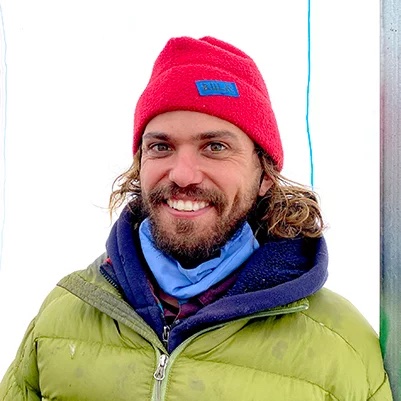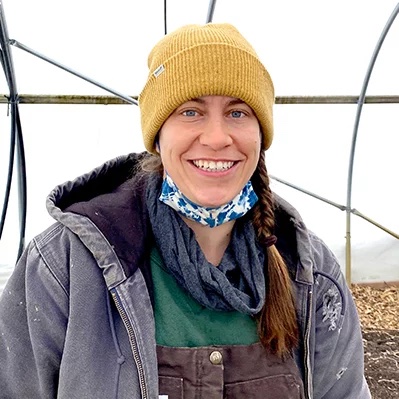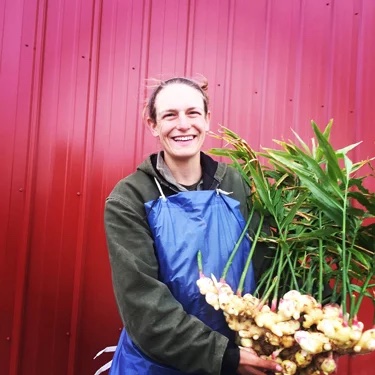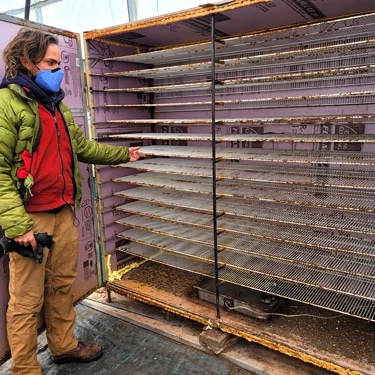
Spring is right around the corner and it's time to start thinking of seeds and nurseries! So, we're bringing in the folks from Green Things Farm Collective - the farming home of its owners Nate, Jill, Michelle, Hannah, and Eric, as well as their farming crew. We had a chance to sit down with Nate, Jill, and Michelle to talk about their seedling production practices - they grow not only for their own farm, but for plant sales and also custom orders for other commercial growers.
Tomm: Hi Nate, Jill, and Michelle. The whole idea here is to share ideas between growers, especially for those folks who are just starting out. We want to help them succeed and avoid some of the struggles that people come across growing their business. We’re coming into nursery season. So many people see seedling production as a means to an end for garden and field production, but its really its own enterprise that needs to be optimized.
So many people don’t have any way to imagine a crop being its own enterprise in a large business. But since you a growing transplants for other businesses, I thought you might have some insights for other businesses.
But first, could you tell us a bit about how you started Green Things and what brought you here?

Nate: We started Green Things pretty low-key with low overhead at the Tilian incubator program. Our second year we bought 64 acres pretty affordably, which meant the sky was the limit for expansion. We knew that we wanted highly diversified and sustainable organic-style production, and we scaled in various ways over the years, but we were struggling with traditional organic tillage-based production on our land, which was pretty depleted conventional ag land. About 3 years ago, we started transitioning to a no-till organic structure and found really good results growing food. It felt like we were finally moving forward in a way that was scalable. This last year, we started a new venture called Green Things Farm Collective with Michelle, Eric and Hannah who were already farmers in the area. They came on as partners in the business and started this amalgamation with more farmers and more production, with the goal being to feed more people and scale up so the farm could better support each of us, as a more sustainable livelihood in the long haul. A little more thoughtful about work-life balance, monetary compensation for the work we're doing - so that has driven some of the expansion for the last few years.
Tomm: You started out doing a lot of year-round production, super CSA oriented, and then you took a step back from that, and you've had a lot of recalibration. I'm curious what has driven those decisions. Has it been the opportunities you've seen, your personal life, trying to find a sweet spot? What has gone into it?
Nate: When we started, the work felt like endless joy. The work wasn't the limiting factor. Over time, other drivers like work-life balance influenced our scale, then as we took on employees and other labor, the management dynamics drove some transitions. We scaled up the number of people on the farm without growing the management systems. We had to take a step back because we realized we weren't equipped to be managing all those people.
Jill: Also, our soil and drainage here is much better suited for fall production and not so much for spring production. We were struggling with our summer CSA. We were having trouble getting things in. But in the Fall our fields really shine, so we shifted production because of that.
Nate: We’ve tried a lot of things. Our end goal is to be happy doing what we’re doing, and I think that’s ultimately changed what we’ve been doing over the years—an evaluation of what we’re doing and why we’re doing it and if we’re happy doing it. Thankfully there seems to be an endless demand in Ann Arbor, so demand hasn’t really driven scale. It hasn’t directly driven how we’ve scaled things, or at least the different enterprises, whether its animals, nursery, fall or spring production. It’s been driven more by what our farm can sustain and not what the demand is.
Tomm: What are some of the stages you’ve come through with seedling production?
Nate: Well when we started at Tilian, there was no nursery there, so were growing super leggy transplants in our house.
Jill: Lights over the dining room table with a tarp over it. Not even grow lights. We had no idea what we were doing. It got us plants. We did buy in some plants from Denae at MSU.
Tomm: Why did you buy them from her instead of growing them on your own?
Jill: Our plants our so horrible we wanted something better.
Nate: Well then we decided we needed our own space. We had a hoop house here, our first big Nifty, and we built a heated space inside of that. A hoop within a hoop, and we just had electric heaters that first year, then we bought a small propane overhead furnace, and that space functioned pretty well. It was efficient because it had the warmth of the hoop house, then the other enclosed space inside. That worked fairly well except for the fact that it was awkward to take away part of the hoop house production space, and the light was an issue since it was three layers altogether and we used regular Home Depot plastic for to enclose the nursery. Also, we put gravel down, which was a whole lot of fun taking out when we eventually moved the nursery. That space functioned for two or three years.
Tomm: Were you able to keep it warm enough for solanum germination?
Nate: We didn’t appreciate just how warm you need to keep a nursery. We struggled with cold transplants for a number of years.
Jill: We used to always keep it at 45 to 50. Now we turn it up to 65.
Nate: We transitioned into a partitioned part of a 30x96. Partitioned all the way to the top poly. The furnace was initially underpowered – kept things from freezing, but not warm enough to grow good transplants. Now we have a 185,000 BTU and we’ll stretch its abilities to keep it warm enough as we move into a 56-foot heated part of the structure this year.
We’ve been having this discussion over this last year about this space we’re moving into. It's such a big investment in our season, but also can be done fairly simply – stone, landscaping fabric, pallet benches, or you can spend $50,000 on rolling benchtops and concrete floors and insulated and heated and fancy germination – sky’s the limit. We’re still feeling out our long term goals, moving toward figuring out how we can offset some of the heat in this space with alternative energy sources, whether it’s a different hoop design, adding some additional geothermal or other passive systems, heat syncs, heat storage, manure heat pumps – a lot of small tweaks. Long term goal to ween ourselves off fossil fuels. We don’t want to pin ourselves into the hoop house, we want to set ourselves up just perfect, so we can take advantage of those technologies when we do build something else out.
Tomm: Why did you start out growing your own transplants? Especially some of the longer-in-the-plug crops… why do you grow them yourselves instead of outsourcing them?
Jill: Its really the money, although I bet if you did a comparison of how much it costs to build and run this space, it’s probably not that much better than just buying them. But also just quality control. We’re responsible wholly for the success or failure of the plant, and that feels good.

Michelle: I also really like it.
Jill: Yeah its fun. And it gives us the opportunity to employ people during the off-season. And we can sell them.
Tomm: So do you break it down and see if you’re really doing well selling TPs to other people? Do you have an understanding of that seedling enterprise?
Jill: I want to say we brought in 14,000 last year, and between our plant sales and our custom transplants for other growers.
Tomm: And its bringing a lot of value to your crop production, right?
Jill: Yes, and we’re certified organic so that limits who we can buy from.
Nate: We maintain a lot of control over our production when we start from the seed, and now we’re going beyond that since we’re growing our own seed now. That might be just personal preference – its not that other people are growing good transplants, but we’re all passionate about the whole process and to relinquish some of that control comes at a cost – not financially maybe, but mentally. We’re stubborn people. And we’ve found ways to make it function financially. We offset some of our nursery production by selling plants and supporting other grower that aren’t equipped with the resources we have here. And it saves time running around going to pick up plants.
Jill: And the timing is really important. You know if you get your plants rootbound they often don’t recover from that. We can see where they’re at day-to-day and make a decision when to plant them.
Nate: And we don’t need to have a transition place to house them between picking them up and planting them.
Michelle: For example this last year, we had those two late frosts and we told people to come and pick up their transplants the week before. But then there were the cold snaps coming so we ended up holding on to them longer than they really should have been.
Tomm: What do you mainly grow for your wholesale plant buyers?
Michelle: Often its solanaceous plants, but we also grow some brassicas and things.
Tomm: So if someone were starting a farm, would you want to sell them plants?

Jill: At this point we’re limited by space. First come first serve. Hesitating to expand our nursery because of fossil fuel concerns. If we could find a really sweet design, I’d be totally in favor of having a massive nursery operation, but all the consumption bothers us.
Nate: It’s a commitment too. The most efficient is a full nursery – even our choice to begin our plantings in March, it feels good to not be heating when its 0 degrees outside. But that being said, in the early spring having only 30-40 trays out, heating this massive space. We’ve messed around with internal hoops and heat mats and whatnot, but it starts getting into what is the scale where you’re totally filling and maximizing the space without kicking yourself. We don’t want to sacrifice out own production to grow transplants for other folks, so we’re still feeling out that rhythm of what is the right scale for our own production, plant sales, and incorporating other growers into that.
Tomm: Do you grow onions?
Nate: We do.
Tomm: So where do you get your onions?
Nate: We grow them ourselves.
Tomm: You start them in March?
Nate: Yes, and we have perfect onions. Better than when we started them in February.
Tomm: Oh wow, so many growers are starting them in January. That’s a lot of time, so folks think maybe we should just buy them in Texas and ship them up.
Nate: Too early, you can start them in March. We were happy to pinch that timeline together.
Jill: We pretty much move it back by a week every year.
Nate: I think it’s a bit of a marketing push by the big onion plant companies.
Michelle: We plant them out with the paper pot transplanter and that works great.
Jill: Although you really need to nail your fertility if you’re planting them later.
Tomm: I think its cool how you use paper pots as a way to reduce risk with rain and the clay fields. If you have a direct seeding that needs to go out into the fields and its raining that week, you’ll plant them into the paper pots.
Jill: Yes, we’re getting better with bed prep now, but that’s a big advantage of the paper pot, in that you can plant a seed that isn’t hardly even germinated yet. But there’s an expense.
Michelle: $3 per chain, 264 plants. They’re great, and for a lot of things its easier to seed with the drop seeder sold by the paper pot company.
Nate: Doesn’t’ work for every seed, and it’s not cheap, but it speeds things up a lot, and they make them for 128s too. It doesn’t singulate very small seeds perfectly so it’s not great for expensive seed. Probably true for any mechanized seeding unless you really have it dialed in. I know you always factored in that 30% as a buffer, and you need that to be calibrated for each crop you’re planting.
Tomm: The great thing about transplants is that you have a plant that’s a month or two months old that’s way ahead of the weeds or you can get them in on that first frost free day, but if you start to think about the efficiency of the whole system, and you can sometimes get away with directly seeding. Are there any crops that you’ve started transplanting but have moved toward direct seeding?
Michelle: Last year we trialed direct sowed winter squash and transplanting and there was no difference, so this year we’re going to do all direct sown with just a tray of backups.
Nate: Someone told me once that you start out direct seeding everything because you don’t have a nursery, but then once you have a nursery you transplant everything since its so reliable, but then as your farm matures and your soil improves and your cultivation methods get better and better, you move back towards direct seeding because there are some real efficiencies to putting those seeds right where they’re going to be and not having transplant shock and things like that.
Jill: We’ll see though – that’s one drawback to having the compost mulch because it dries out so quickly. Transplants are so reliable. The pure compost is super duffy and totally black so it dries out quickly. We’ve had some germination problems with the soil surface drying out.
Tomm: Are there any inventions that you’ve made to make your transplant production go more smoothly?
Jill: Its important to have a hardening off space. We just have a small caterpillar tunnel with opaque plastic over top of it. We use it as an overflow area as well.
Nate: We finally got a shade cloth that we put on in May and June, which really helps with our fall brassicas and our weekly lettuce plantings – takes the edge off for sure. Also circulation fans really help during the heated time to prevent hot and dry spots. Circulation fans really help to distribute the heat.
Jill: Fertile pots for more delicate plants. It does some air pruning and helps with transplant shock – we’re going to do it with our hoop house tomatoes again this year.
Michelle: The rest going into regular plug trays.

Nate: Every farm should have some kind of germination chamber – just an insulated box, or a bread proofing chamber that doesn’t work anymore. Just an insulated box with tight shelves that can hold a single tray. We can fit 72 trays in ours. In the bottom is a chafing pan with a water heating element and a water tank with a float valves – all on a thermostat and the tray heats up produces a warm steam that keeps it warm and humid. We can keep it really accurately at the temperature we need for whatever seed. And in the summer because its insulated it keeps it cooler for germing most things in summer.
Tomm: So you’re not needing to water them before germ? That’s huge for a lot of things like celery that are so long in the tray.
Nate: Nope we water them initially and its humid enough in there to keep them hydrated until germination.
Jill: We’re also a big fan of jumpstart from Ohio Earth Foods for our transplant media, and we’re foliar feeding them with a hose-mounted injector once a week. It has a little kelp, a little mycorrhizae. It’s great. Also having a table and a special seeding zone is really big. Also the space also doubles as curing for squash or garlic.
Tomm: You say you want to retain control of all aspects of your production, but you relinquish this for your transplant media. What’s the difference?
Jill: Well just look at the ingredient list on this soil mix. It’s like twenty ingredients. We’d need to be out there with teaspoons and with all the handling… We’ve been getting them in 30 pound bags now instead of the big totes because we’ve had issues with the big bags drying out and becoming basically a big dust bin.
Nate: They also hold up really well from season to season in the bags and I’m guessing its not any more plastic than using the big heavy duty tote bags.
Tomm: Have you had any issue with Pythium or damping off in your transplant production?
Nate: Yes, raising the temperature has helped a lot and sanitation. We’ve messed around with a little Serenade here and there, but dialing in our watering practices has had the biggest effect. Letting things dry out all the way before watering.
Jill: Having fewer people watering in the nursery and being more in-tune with what’s going on is really important. If there’s a cucumber in there that’s already saturated and is getting watered three times a day its not going to work out well.
Nate: A dynamic that we’re still learning about, the next level, is that the water than you’re using can have a big impact on the plants. We have extremely hard water with high bicarbonate levels. A lot of the crusting that we have is evaporated bicarbonates. In the big nurseries they aren’t watering with straight well water, they are filtering and reverse osmosis with pH balancing. We played around with a reverse osmosis system that wasn’t scaled to what we need, but a lot of the larger nurseries use that. If you’re starting out and dealing with funky things in the soil and crusting, its worth sampling your water and seeing if some of the answer might lie in your water source especially if you’re using surface water or municipal water with chlorine or other things that are injected into city water supplies. We’re still looking for the right resource. It’s been on our mind how it’s having an effect on our transplants.
Tomm: I remember when I was watering in the basement with city water I’d always let a five gallon bucket off to let the chlorine cook off
Tomm: Do you have any other tips for new growers just starting out with transplant production?
Jill: Don’t start them too early.
Nate: Keep your heat as high as you can justify. Heat and light are the two limiting factor for plants early in the season. Invest in good growing media whether you’re making it yourself or buying it in. Grow your plants in something they’re going to be happy living in.







